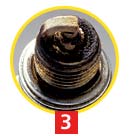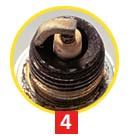SPARK PLUG DIAGNOSIS
Diagnostic of Failure
| Failure | Cause | Consequences | Fig. |
|---|---|---|---|
| Improperly adjusted ignition system | Spark advance (from a proper moment) | Pre - ignitions /Detonation burning | 2 |
| Spark delay (from a proper moment) | Excessive formation of combustion deposits | 1 | |
| Improper air/fuel ratio | Rich mixture | Excessive formation of combustion deposits | 1 |
| Lean mixture | Pre - ignitions /Detonation burning | 2 | |
| Low or no performance of the air filter | Dust penetration into the combustion area | Excessive deposits | 3 |
| Filter impassability | Excessive formation of combustion deposits | 1 | |
| Compression pressure | Low | Excessive formation of combustion deposits | 1 |
| Improperly selected spark plug | Too hot | Pre - ignitions Detonation burning | 2 |
| Too cold | Excessive formation of combustion deposits | 1 | |
| None | Perfect performance of the spark plug | 4 |




Spark plug is like a dipstick into your engine, which will let you see what is going on inside of the combustion chamber.
The two most destructive combustion events to the engine and the Spark Plug are: PRE-IGNITION and DETONATION. These terms are commonly misunderstood and confused with each other.
Detonation occurs after normal combustion (controlled burning) was initiated from a spark between spark plug electrodes. As the flame front propagate trough the combustion chamber, the pressure and heat on the remaining yet un-burnt mixture increases dramatically pass the point of fuel octane rating and any hot spot (most often hot side of the piston) will detonate (explode) the remaining yet un-burnt mixture. This event takes place in a split second and cause extreme pressure shock wave, which often pits the piston surface (looks sandblasted as it compresses less dense micro-portions of the aluminum alloy) and almost always breaks ceramic insulator on the spark plug. The damage to the spark plug is a result of the events and the high frequency shock wave. Please note that detonation is a different event than pre-ignition where the mixture is ignited by usually hot spot, glowing carbon deposit or overheated ground spark plug electrode, prior to the mixture ignition by spark form spark plug. Pre-ignition is far more destructive to the engine than detonation because maximum cylinder pressure is reached far before the piston reach the TDC (top dead center). Pre-ignition will destroy the engine, put hole trough the piston, or even blow it up. Detonation (can be also heard as engine knock or pinging) is not necessarily damaging to the engine if it is not prolonged and only very small amount of un-burnt mixture detonate. Modern engines in order to reach the maximum fuel economy run on the edge of pinging. They use knock sensors to "listen" for the pinging and retard the timing accordingly. However prolonged and severe detonation will hurt the engine and the spark plug, and is probably the most common cause of failure due to inconsistency of the octane rating of gasoline. Modern engines are equipped with a Knock Sensor which provides feed back to engine ECU/PCM to adjust engine ignition timing in order to prevent prolonged detonation. However engine knock sensor is often not working properly, or is purposely eliminated on some performance applications, which exposes engine and spark plug to damage from severe detonation. Spark plug is passive component with 3 basic functions. It have to: 1) stay cool enough to prevent pre-ignition 2) stay hot enough to burn off combustion deposits 3) provide spark to ignite A/F mixture. About the only time you can blame spark plug for a failure, is if too hot spark plug heat range is used and the spark plug ground electrode gets too hot and become a source of the pre-ignition.









